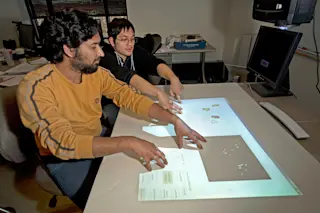The next step in touch-screens may be to ditch the actual screen, according to researchers at Purdue University. Engineers Karthik Ramani and Niklas Elmqvist and their colleagues recently unveiled a projector-based computer input system that can transform desks, office walls, or even kitchen islands into interactive surfaces.
The system, called extended multitouch, consists of a computer, a projector, and a Microsoft Kinect depth-sensing camera. (Also used for the Xbox 360, Kinect enables users to interact with games and devices optically, without touching anything.) The projector displays the contents of a typical computer screen onto a surface like your refrigerator or stone countertop, while the Kinect’s infrared laser and receiver estimate the distance to the surface.
Any surface transforms into a touch-screen with the extended multitouch system. It can decipher several hands, (left) translating their shapes into computerized images (center) and maps of each hand's touchpoints (right). | C-Design Lab/Purdue University
...















